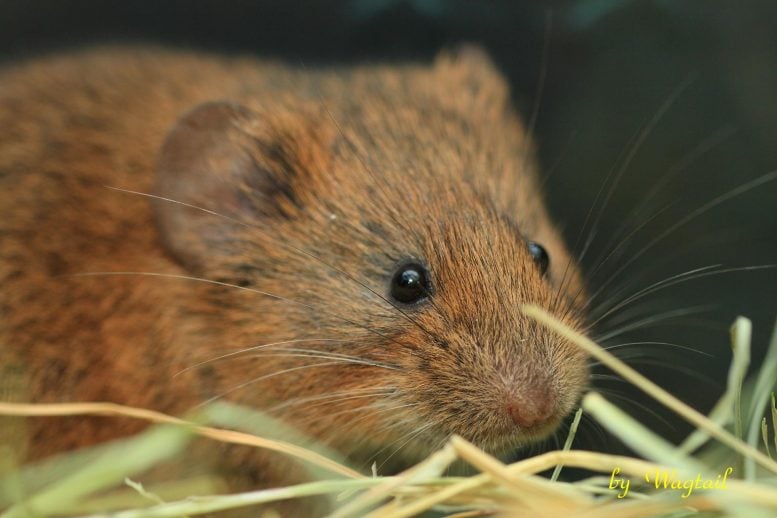
A Taiwan vole, closely related to the creeping vole described in the study. Credit: Lai Wagtail / Flickr (CC BY-NC-ND 2.0)
Open up Scott Roy’s Twitter bio and you’ll see a simple but revealing sentence: “The more I learn the more I’m confused.” Now the rest of the scientific world can share in his confusion. The San Francisco State University associate professor of Biology’s most recent research, published earlier this month in one of the scientific world’s most prestigious journals, catalogs a strange and confounding system of genes in a tiny rodent that scientists have ignored for decades.
“This is basically the weirdest sex chromosome system known to science,” Roy said. “Nobody ordered this.” But he’s serving it anyway.
The owner of those chromosomes is the creeping vole, a burrowing rodent native to the Pacific Northwest. Scientists have known since the ’60s that the species had some odd genes: Their number of X and Y chromosomes (bundles of DNA that play a large role in determining sex) is off from what’s expected in male and female mammals.
That finding caught Roy’s eye when presented by a guest speaker at a San Francisco State seminar, and he realized that modern technology might be able to shed new light on the mysteries hiding in the voles’ DNA. After working with collaborators to disentangle the voles’ genetic history — resulting in one of the most completely sequenced mammal genomes that exist, according to Roy — the story only got stranger.
The team found that the X and Y chromosomes had fused somewhere in the rodents’ past, and that the X chromosome in males started looking and acting like a Y chromosome. The numbers of X chromosomes in male and female voles changed too, along with smaller pieces of DNA getting swapped between them. The researchers published their results in Science on May 7, 2021.
Drastic genetic changes like these are exceptionally rare: The way genes determine sex in mammals has stayed mostly the same for about 180 million years, Roy explains. “Mammals, with few exceptions, are kind of boring,” he said. “Previously we would have thought something like this is impossible.”
So how did the genes of this unassuming rodent end up so jumbled? It’s not an easy question to answer, especially since evolution is bound to produce some strangeness simply by chance. Roy, however, is determined to figure out the “why.” He suspects that what the team found in the vole’s genome is something like the aftermath of an evolutionary battle for dominance between the X and Y chromosomes.
The research couldn’t have happened, Roy says, without collaborations with Oregon fish and wildlife biologists who had a creeping vole sample sitting in a lab freezer. He also teamed up with a group from Oklahoma State University when the two groups started chatting about creeping vole DNA sequences that were posted on the internet — and both realized they were working on the same question.
Another key was working at a teaching-focused institution. Roy says he has the time to develop ideas with colleagues and students at SF State, and he can do research where he doesn’t quite know what he’ll find. “This is a great example of non-hypothesis-based biology,” Roy explained. “The hypothesis was, ‘This system is interesting. I bet if you looked into it some more, there’d be other interesting things.’”
It won’t be the last time Roy’s lab goes out on a limb. He and his collaborators plan to look into the genomes of other species related to the voles to chart the evolutionary path that led to this strange system. He’ll also continue DNA sequencing curiosities across the tree of life.
“These bizarre systems give us a handhold to start to understand why the more common systems are the way they are and why our biology works as it does,” he explained. By delving into the weirdest that nature has to offer, maybe we can come to understand ourselves better, too.
Reference: “Sex chromosome transformation and the origin of a male-specific X chromosome in the creeping vole” by Matthew B. Couger, Scott W. Roy, Noelle Anderson, Landen Gozashti, Stacy Pirro, Lindsay S. Millward, Michelle Kim, Duncan Kilburn, Kelvin J. Liu, Todd M. Wilson, Clinton W. Epps, Laurie Dizney, Luis A. Ruedas and Polly Campbell, 7 May 2021, Science.
DOI: 10.1126/science.abg7019









Soooo…, everything we thought we knew about X & Y is wrong?
No, this was an one off and that is the rule – “there are no rules” in evolution. But besides exploding the ‘boring’ XY (or other dominant sex systems) the mechanism can be “something like the aftermath of an evolutionary battle for dominance between the X and Y chromosome” which reflect also in the egg-sperm battles.
Babu G. Ranganathan*
(B.A. Bible/Biology)
HOW DOES DNA TURN A CELL INTO A MOUSE, OR A BIRD, OR A HUMAN?
When you divide a cake, the cake never gets bigger. However, when we were just a single cell and that cell kept dividing we got bigger. New material had to come from somewhere. That new material came from food.
Just as the sequence of various letters and words in human language communicate a message and direct workers to build and assemble something so, too, the sequence of various molecules in our DNA (our genes or genetic code) directed the molecules from our mother’s food, that we received in the womb, to become new cells, eventually forming all the tissues and organs of our body.
When you feed a cat your food the cat’s DNA will direct the food molecules to become the cells, tissues, and organs of a cat, but your DNA will turn the same food into human cells, tissues, and organs.
What we call “genes” are actually segments of the DNA molecule. When you understand how your DNA works, you’ll also understand how egg yolks can turn into chickens. Read my popular Internet article: HOW DID MY DNA MAKE ME? Just google the title to access the article.
This article will give you a good understanding of how DNA, as well as cloning and genetic engineering. You also learn that so-called “Junk DNA” isn’t junk at all. You will learn why it is not rational to believe that DNA code could have arisen by chance. Science points (not proves, but points) to an intelligent cause for DNA code.
What about genetic and biological similarities between species? Genetic information, like other forms of information, cannot happen by chance, so it is more logical to believe that genetic and biological similarities between all forms of life are due to a common Designer who designed similar functions for similar purposes. It doesn’t mean all forms of life are biologically related! Only genetic similarities within a natural species proves relationship because it’s only within a natural species that members can interbreed and reproduce.
Nature cannot build DNA code from scratch. It requires already existing DNA code to direct and bring about more DNA code or a genetic engineer in the laboratory using intelligent design and highly sophisticated technology to bring DNA code into existence from scratch. Furthermore, RNA/DNA and proteins are mutually dependent (one cannot come into existence without the other two) and cannot “survive” or function outside of a complete and living cell. DNA code owes its existence to the first Genetic Engineer – God!
Protein molecules require that various amino acids come together in a precise sequence, just like the letters in a sentence. If they’re not in the right sequence the protein won’t function. DNA and RNA require for various their various nucleic acids to be in the right sequence.
Furthermore, there are left-handed and right-handed amino acids and there are left-handed and right-handed nucleic acids. Protein molecules require for all their amino acids to be left-handed only and in the right sequence. DNA and RNA require for all their nucleic acids to be right-handed and in the right sequence. It would take a miracle for DNA, RNA, and proteins to arise by chance!
Mathematicians have said any event in the universe with odds of 10 to 50th power or greater is impossible! The probability of just an average size protein molecule (with its amino acids in the right sequence) arising by chance is 10 to the 65th power. Even the simplest cell is made up of many millions of various protein molecules along with and DNA/RNA..
The late great British scientist Sir Frederick Hoyle calculated that the odds of even the simplest cell coming into existence by chance is 10 to the 40,000th power! How large is this? Consider that the total number of atoms in our universe is 10 to the 82nd power.
Also, so-called “Junk DNA” isn’t junk. Although these “non-coding” segments of DNA don’t code for proteins, they have recently been found to be vital in regulating gene expression (i.e. when, where, and how genes are expressed, so they’re not “junk”). Also, there is evidence that, in certain situations, they can code for proteins through the cell’s use of a complex “read-through” mechanism.
Visit my latest Internet site: THE SCIENCE SUPPORTING CREATION (This site answers many arguments, both old and new, that have been used by evolutionists to support their theory)
Author of the popular Internet article, TRADITIONAL DOCTRINE OF HELL EVOLVED FROM GREEK ROOTS
*I have given successful lectures (with question and answer period afterwards) defending creation before evolutionist science faculty and students at various colleges and universities. I’ve been privileged to be recognized in the 24th edition of Marquis “Who’s Who in The East.”
Meaningless superstition, linking to pseudoscience.
Also, science already knows evolution is the basic process in biology.